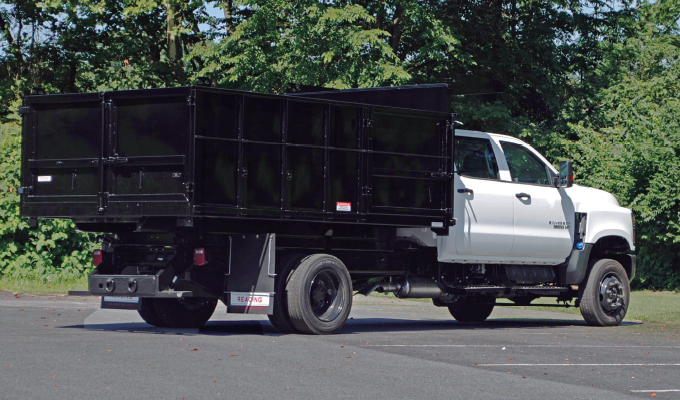Got some landscape body questions you’d like answered by the experts? Well, here’s your intro class for all things landscape truck bodies taught by none other than the experts at Reading Truck Body. Take a seat at your desk and grab a paper and pencil; you’ll want to take notes.
Q: HOW IMPORTANT IS IT TO CHOOSE THE RIGHT TRUCK BODY?
A: In the Northeast a landscape body refers to a platform body with fixed high sides, swing doors at the rear and one side, and a full cab shield. This sort of body is used for hauling plant debris and mulch. Traditional dump bodies are also used when hauling heavy products such as pavers and aggregate. In the southern areas of the country a landscape body refers to a long fixed platform with a fold down “beaver tail” ramp used to haul large mowers.
Regardless of the application, it’s always important to assess what you intend to use the vehicle for prior to making a decision. Key factors to consider include defining what you will be hauling (payload), what length you will need, and how the body will be used on a daily basis. This will help to inform your choice.
Q: WHAT TRUCK BODY IS GREAT FOR LANDSCAPE AND WHY?
A: Reading’s SL Landscape body incorporates fixed, fully welded sides and front bulkhead along with swinging rear doors and a wide swing door on the passenger side for loading large pallets of stone and block. The body includes integrated tarp cleats and a full cab shield for stowing wheelbarrows. The entire body is fully welded for structural integrity.
Q: WHAT STYLE OF TRUCK BODY DO YOU SUGGEST FOR COMMERCIAL LANDSCAPING?
A: Reading REV-PAC® tool box can be used between the chassis cab and body—either landscape or dump body. It’s a great option for additional heavy-duty storage, too. It provides safe, secure, and reliable compartments for gear such as gas-powered saws and trimming equipment. Just about every Reading upfit also includes a Class V hitch in order to tow skid loaders, backhoes, and other heavy equipment for site preparation.
Q: WHAT STYLE OF TRUCK BODY DO YOU SUGGEST FOR RESIDENTIAL LANDSCAPING?
A: Standard Class 2 and Class 3 pickup trucks are most commonly used for smaller, residential landscaping projects. These can be upfitted with a small 8-ft dump insert for hauling wood, mulch, etc. They’re also used for plowing or can be altered in order to add a service body often used by lawn sprinkler contractors. The service body adds the ability to stow and manage small fittings used in a sprinkler systems.
Q: WHAT ARE SOME TRUCK BODY MAINTENANCE TIPS YOU CAN SHARE FOR SMOOTH OPERATIONS AND LITTLE DOWNTIME?
A: Given the very corrosive nature of road salt and calcium chloride, equipment should be maintained on a daily basis—especially in the northern areas of the country. By raising up landscape or dump bodies then spraying off these chemicals, companies will greatly increase the lifespan of their equipment by controlling rust. The hydraulic hoses and fittings should also be inspected to decrease downtime associated with losing line pressure and operation of the bodies while in the field.
Q: WHAT TRUCK WOULD YOU RECOMMEND TO CUSTOMERS INTERESTED IN PURCHASING A READING TRUCK BODY FOR THEIR LANDSCAPE APPLICATION?
A: Class 4 and Class 5 crew cab chassis. These trucks have great in-cab storage and they are also able to hold five passengers. They also tend to be the best-suited trucks to handle the loads and towing requirements of the landscape industry. Given the expense of emissions laden diesel engines, many landscaping companies have moved to gasoline-powered engines over the last several years. Landscaping vehicles generally sit idle while crews tend to neighborhoods for long periods of time thus limiting the amount of miles accruing on these vehicles.
FOR MORE INFORMATION
Ryan Reese and Jeff VanDeMotter of Reading Truck contributed to this article. Reading Truck Body manufactures truck bodies for a variety of industries including construction, HVAC, oil and gas, and landscape and nursery. Find out more about landscape bodies and tips, visit www.readingbody.com.




